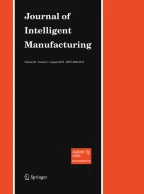Abstract
This paper presents a Mahalanobis-Taguchi System (MTS) based methodology that detects grip length of bolted joints in real-time during fastening. Grip length is the length of the unthreaded portion of a bolt shaft. When the total thickness of joining members is greater than the grip length of the bolt, it is called under-grip, which compromises the structural integrity of a joint. In this study, a pneumatic, hand-held, rotary-type tool for bolted joints is integrated with a torque sensor and an optical encoder in order to obtain torque-angle signatures. Then, the signature is processed in real-time using the MTS-based approach in order to detect the grip-length, all of which occurs in real-time as the fastening process is completed. The proposed approach is also applied to detect the presence of re-used fasteners, which is another quality concern since some material properties and physical conditions of bolts and nuts can change if they are reused several times. The proposed approach reads in various characteristics from the torque-angle process signature, including mean and standard deviation of the torque-over-angle and angle-over-torque ratios, total angle turned, and work done during the different stages of the fastening process in order to infer about the quality of the bolted joint. The experimental results show that the proposed approach is successful with an accuracy of over 95% in detecting various grip lengths and presence of re-used fasteners.
Similar content being viewed by others
References
Boys J.T., Wallace P.W. (1977) Design and performance of an automatic control system for fastener tightening. Proceedings of the Institute of Mechanical Engineers 191: 371–380. doi:10.1243/PIME_PROC_1977_191_045_02
Chinnam, R. B., Rai, B., & Singh, N. (2004). Tool-condition monitoring from degradation signals using Mahalanobis-Taguchi System analysis. In Proceedings of ASI’s 20th Annual Symposium of Robust Engineering pp. 343–351.
Drumheller, J. (2000). Advanced torque auditing methods. Society of Manufacturing Engineers (SME) Technical Report SME AD00-156.
Fonda, J., Zawodniok, M., Jagannathan, S., & Watkins, S. E. (2006, October 4–6). Development and implementation of optimized energy-delay sub-network routing protocol for wireless sensor networks. In Proceedings of the IEEE International Symposium on Intelligent Control, pp. 119–124.
Giannoccaro, N. I., Klingajay, M. (2004, August 4–6). Identification of threaded fastening parameters based on Least Square method. In Proceedings of the Society of Instrument and Control Engineers (SICE) Annual Conference in Sapporo, Vol. 3, pp. 2592–2597.
Klingajay, M., & Giannoccaro, N. I. (2003, December 10–12). Comparison between Least Square and Newton Raphson for estimation parameters of autonomous threaded fastenings. In IEEE International Conference on Industrial Technology, Vol. 1, 163–168.
Klingajay M., Giannoccaro N.I. (2004) The automated threaded fastening based on on-line identification. International Journal of Advanced Robotic Systems 1(4): 263–272
Klingajay, M., Seneviratne, L. D., & Althoefer, K. (2003, October 27–31). Identification of threaded fastening parameters using the Newton Raphson method. In Proceedings of the 2003 IEEE International Conference on Intelligent Robots and Systems, Vol. 2, pp. 2055–2060.
Lara, B., Althoefer, K., & Seneviratne, L. D. (1998, August 31–September 4). Automated robot-based screw insertion system. In Proceedings of the 24th Annual Conference of the IEEE Industrial Electronics Society, pp. 2440–2445.
Nevis J.L., Whitney D.E. (1978) Computer-controlled assembly. Scientific American 238(2): 62–74
Rosenstengel J., Miller I., DeSirnio M., Derriso M., Brown K., Braisted W. et al (2004) Detection of fastener failure in a thermal protection system panel. Proceedings of the IEEE Aerospace Conference 4: 2464–2473
Seneviratne, L. D., & Visuwan, P. (1999, November 16–20). Weightless neural network based monitoring of screw fastenings in automated assembly. In Proceedings of the 6th International Conference on Neural Information Processing, Vol. 1, pp. 353–358.
Shigley J.E., Mischke C.R. (1986) Mechanical engineering design. McGraw-Hill, New York, NY
Shoberg, R. S. (2000). Mechanical testing of threaded fastener and bolted joints (pp. 811–835). Materials Park, Ohio: ASM (American Society for Materials) International.
Srinivasaraghavan J., Allada V. (2006) Application of Mahalanobis distance as a lean assessment metric. International Journal of Advanced Manufacturing Technology 29(11–12): 1159–1168. doi:10.1007/s00170-005-0004-2
Taguchi G., Chowdhury S., Wu Y. (2001) The Mahalanobis-Taguchi system. McGraw-Hill, New York, NY
Taguchi G., Jugulum R. (2002) The Mahalanobis-Taguchi strategy—a pattern technology system. John Wiley &Sons, New York
Toor, P. M. (1995). Structural integrity of fasteners. American Society for Testing and Materials (ASTM Special Technical Publication, No. 1236), pp. 9–23.
Toth G.R. (2003) Controlled tightening over the yield point of a screw: based on Taylor’s Series expansions. Journal of Pressure Vessel Technology 125: 460–466. doi:10.1115/1.1613299
Wang H., Chiu C., Su C. (2004) Data classification using Mahalanobis Taguchi System. Journal of the Chinese Institute of Industrial Engineers 21(6): 606–618
Xu R., Wunsch D. (2005) Survey of clustering algorithms. IEEE Transactions on Neural Networks 16(3): 645–678. doi:10.1109/TNN.2005.845141
Author information
Authors and Affiliations
Corresponding author
Rights and permissions
About this article
Cite this article
Saygin, C., Mohan, D. & Sarangapani, J. Real-time detection of grip length during fastening of bolted joints: a Mahalanobis-Taguchi system (MTS) based approach. J Intell Manuf 21, 377–392 (2010). https://doi.org/10.1007/s10845-008-0186-1
Received:
Accepted:
Published:
Issue Date:
DOI: https://doi.org/10.1007/s10845-008-0186-1
